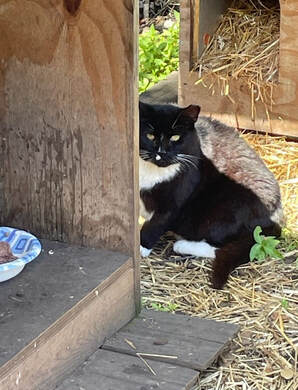 A “working cat” refers to a feral cat that is cared for (fed, sheltered, provided with medical care) by someone in exchange for the cat’s natural brand of pest control. Working Cats Programs grew out of TNR programs to provide the best option for unsocialized cats who had been trapped and sterilized but could not be returned to their original locations due to any number of reasons, such as the area being or having become unsafe for a cat to live. In such situations, rescues will hold onto the cats and put them up for adoption. These cats are not suited to be typical pets that live indoors and are handled often, but the people who adopt them are looking more for a partner than a pet. Alley Cat Rescue has operated a Working Cats Program as a last resort for feral cats who could not stay in their outdoor homes. To date, we have helped 4,500 feral and semi-feral cats in seven states through our Working Cats Program. In one case, when the authorities of Riverside State Park refused to allow the 10 colonies living there to remain on the land, ACR relocated them as working cats. Although relocation is not our preference for any cat, in some situations such as this one there are no safe alternatives. Over time, we have been happy to see more independent Working Cats Programs forming and county and city Working Cat Programs popping up around the country! One well-publicised program in Chicago has released 1,000 cats throughout the city to control a serious rat problem. Similar programs have already proven successful in Philadelphia, Washington D.C., and New York City. A list of Working Cats programs by state can be found at saveacat.org/shelters-with-working-cat-programs.html.
2 Comments
7/18/2021 10:51:21 am
That is a wonder story I read the hold thing I love cats I also resue a cat that was living in the street there owners just left her out in the street she kept coming to my door too eat a d then she wanted to go back out I didn’t know if she was fix to I took her too vet too fine out she had aides so then I decided to keep her in my house took 1 week fir her to settle down she happy now and save I love her snd she’s good
Reply
SHARON HOLLADAY
7/24/2021 11:50:04 am
I, as well as all my family, love all animals. It makes me so happy to hear that the TNR program for feral cats is working and that more and more shelters are becoming "no-kill" shelters. A while back, a young female brought 3 kittens to our front yard which, with good luck, I was able to tame (except for Momma-Cat). Unfortunately, less than 3 months later, before we were able to catch and fix Momma-Cat, she arrived at our front door with 6 more kittens. My husband and I were able to finally catch them and get all 9 checked, get them fixed and get them all their shots. We had a hard time catching Momma-Cat but finally did. She never let us get near her even though she would come into our house to nurse the kittens but leave when the kittens finished nursing. The kittens would stay in the family room but would panic if I shut the door. I did my best to try and tame them but it didn't work out as well as it did with her 1st 3 kittens. Unfortunately 3 of the 6 took off about 9-11 months later and Momma-cat left and did not return about 1 year after that. I keep hoping she and the other 3 kittens might return one day or at least that someone is caring for them and that they are safe.
Reply
Leave a Reply. |
Details
AuthorAlley Cat Rescue is leading in the way in promoting humane and compassionate care for ALL cats. Archives
January 2024
Categories
All
|
 RSS Feed
RSS Feed